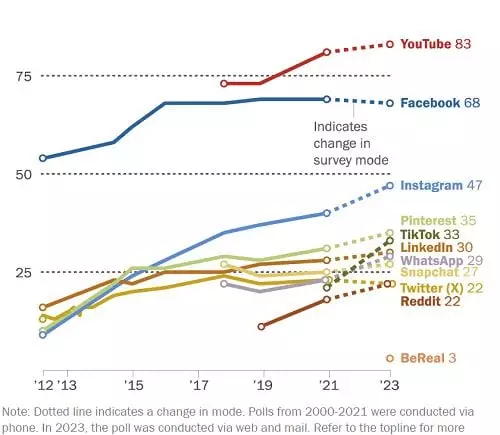In the ever-changing realm of social media, YouTube has maintained its position as the leader in online video platforms. However, over the past two years, TikTok has emerged as a significant player, experiencing exponential growth. These findings, unveiled in Pew Research’s latest report titled “Americans’ Social Media Use,” shed light on the current trends in social app usage. The report, based on a comprehensive survey of more than 5,000 U.S. social media users, reveals that amid the vast array of platforms available, YouTube continues to be the most widely used. Facebook, Instagram, and Pinterest also rank high in usage.
While Pinterest’s popularity may not come as a surprise, its staggering 96 million North American users warrant attention. This visually-oriented platform has become a central hub for users seeking shopping-related content. On the other hand, the mysterious X app, which boasts a relatively small user base, continues to puzzle researchers in terms of its widespread influence. While these findings are not groundbreaking discoveries, they offer valuable insights into user engagement and the potential for reaching target audiences through strategic promotions.
Analyzing the data compiled by Pew Research, it is evident that there have been no monumental shifts in popularity among social media platforms. However, Instagram, TikTok, and Reddit have all experienced an increase in usage compared to previous surveys. Instagram, in particular, has a strong presence among younger users, with 78% of 18 to 29-year-olds actively using the platform. In contrast, only 15% of those aged 65 and above engage with Instagram. Snapchat, a popular choice among younger demographics, is used by 65% of U.S. adults under 30, while a mere 4% of individuals over 65 partake in Snapchat. TikTok, known for its viral content and short videos, is predominantly utilized by 62% of 18 to 29-year-olds, while only 10% of those aged 65 and older are active on the platform. While these usage trends are predictable, it is essential to consider them when devising strategies to engage with your target audience effectively.
Understanding the changing landscape of social media is crucial for businesses and marketers alike. As platforms continually evolve, it is essential to adapt your marketing approach to better reach and engage with your audience. With YouTube maintaining its position as the dominant force in online video, it is vital to incorporate this platform into your video marketing strategies. Facebook’s wide user base and Instagram’s popularity among younger demographics present valuable opportunities for businesses seeking to connect with their target audience. Pinterest’s extensive user base provides a unique platform for showcasing visually appealing and shopping-oriented content.
Additionally, the rise of TikTok should not be underestimated. As this platform continues to gain traction, particularly among younger users, integrating TikTok into your marketing strategy can help garner attention and establish your brand’s presence among this demographic.
In an ever-changing social media landscape, YouTube remains the leader, while TikTok has experienced significant growth. Understanding the popularity trends and demographic usage patterns across different platforms can enhance your ability to connect with your target audience effectively. Incorporating platforms such as Facebook, Instagram, Pinterest, and emerging platforms like TikTok into your marketing strategies can help optimize engagement and drive meaningful results. Stay ahead of the curve by continually monitoring social media trends and adapting your approach to ensure your message resonates with your audience wherever they engage.


Leave a Reply